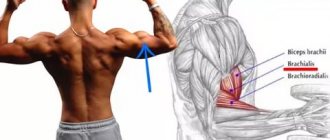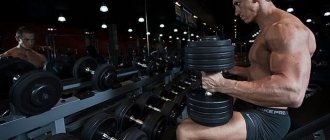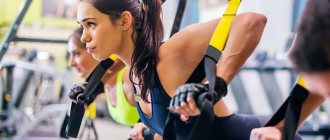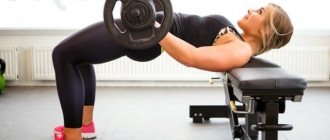Many people don't consider forearm training a priority for them. Huge shoulders, a wheel chest and sculpted quadriceps muscles are the dream of many. But what about the details?
There are no unnecessary trifles in bodybuilding and working on your body. Practicing the details helps build a beautiful body, starting from the head to the toes. The hamstrings, calves, rear deltoids and forearms are among the little things that, when properly developed, create a balanced and proportional body.
It is these seemingly insignificant details that can help you win or lose a bodybuilding competition, or simply make others admire you. Think about what massive shoulders are worth without a pair of tightly built forearms?
What will you get if you decide to pump up your forearms?
While they complement your look, they will also help you develop strength and functionality when lifting weights, and will later help you build mass in other areas such as your back, shoulders and biceps.
The forearms are indeed stimulated through lifting movements such as bending, lifting, and chin-ups/pulldowns, but in order for an athlete to reach their full potential and build strength in their forearms (especially if they are a weak point), they must incorporate specific training into their program .
However, this does not mean that you need to do one or two movements at the end of your arm training day and perform the exercises at minimal intensity.
Can't wait to start training your forearms? We have prepared for you a basic advanced program that is suitable for all levels of training. Take it on a separate day of training or combine it with back/leg training.
Winding a rope with a suspended load onto a crossbar
There is another original technique that will help you figure out how to pump up your forearms. We are talking about winding a rope with a load. The workout tightens a wide range of small muscles in the target area. As equipment you should use a straight stick and a weight in the form of a pancake from a barbell. Tie the weight to the end of a strong thin rope. Fix the second end securely on the stick.
Take a vertical stance. Grab the previously prepared crossbar with both hands from opposite edges. Hang the weight on a rope above the floor surface. Place your upper limbs in front of you parallel to the ground. Place your feet at shoulder level for stability. Alternately perform movements with your hands, winding a rope with a suspended weight around a stick. When the load reaches its highest point, slowly unwind the device back. Perform several cycles. Then rest for a couple of minutes and repeat the above steps again.
How to pump up your forearms
Hammer grip dumbbell curls
- 3 sets of 10-15 reps
- Body part: Biceps Equipment: Dumbbells
Hammer grip bicep curls on a Scott bench
- 3 sets of 10-15 reps
- Body part: Biceps Equipment: Dumbbells
Biceps curl on the lower block
- 3 sets of 10-15 reps
- Body Part: Biceps Equipment: Block
Wrist Curl on Dumbbell Bench, Palms Down
- 3 sets of 10-15 reps
- Body part: Forearms and wrists Equipment: Dumbbells
Bend the wrists on the lower block while sitting on a bench
- 3 sets of 10-15 reps
- Body Part: Forearms and Wrists Equipment: Block
Add to Calendar * Add to My Workouts * Print Workout
* — The service is in beta testing
A quality set of forearm exercises deserves the same attention and discipline as squats or presses. A well thought out plan of action that includes proper volume, intensity and use of different angles is the best way to achieve maximum development.
Additional exercises with dumbbells
The barbell is not suitable for some exercises, so other sports equipment comes to the rescue.
Pumping up the forearms will not be as effective if you don’t pump up the sides of this part of the arms. And this implies movements in the wrist joint to the right and left in the plane of the palm, which is impossible to do with a bar.
So let's look at a couple of exercises for the forearms with dumbbells.
The first is done like this:
- Sit on a bench, first holding a dumbbell in your hand. Place your hand on your knee so that the dumbbell is perpendicular to the floor. That is, pancakes up and down. If you take 2 dumbbells and place both hands in this way, your palms will face each other.
- Move the hand and dumbbell up and down with maximum amplitude. The movements will be minor, but this helps to finish off the muscles and use certain bundles of the forearms.
To pump up the other side of your hand, you need to do this:
- Take a dumbbell and sit on a bench.
- Place one hand with your elbow on your knee, bending it.
- Raise your other arm so that your elbow and shoulder are at the same level.
- Place the second hand closer to the wrist in the first hand. That is, with the palm of your lower hand you should clasp your upper hand near the wrist. Thus, the elbow of the second hand will point slightly upward. If you raise your hand above your elbow, it will be even better.
- Hold the dumbbell with your other hand and move your hand up and down. The amplitude will again be insignificant - this is normal. In this plane the joint has limited mobility.
In general, these two exercises are more about subtleties. You can limit yourself to just working with a barbell. This is enough to create muscle mass in the arms below the elbow.
If you don’t have a barbell, you can use dumbbells instead and do the same exercises, plus an option when your palms are oriented towards each other.
To have pumped up forearms, it is enough to work them out once a week. You can do this on any training day.
A quick lesson in forearm anatomy
Surprisingly, the forearms are a complex group of small muscles with multiple functions. The brachialis and brachioradialis muscles help flex the arm at the elbow and assist the forearm during flexion.
These muscles work during all flexion movements. The pronator teres muscle helps the forearm in the prone position, as well as when bending the arm at the elbow joint.
The flexor muscles - palmaris longus, flexor carpi radialis and flexor carpi ulnaris - flex the palm, and the extensor muscles - ulnaris and extensor carpi radialis brevis - extend it.
To tone your forearms in a balanced manner, you need a comprehensive resistance training program that includes exercises for all parts of the forearm.
Static load holding
Another way to pump up your forearms? A good solution would be to keep the discs hanging from the barbell. Performing the exercise promotes the progressive development of local muscle strength. Achieving impressive volumes in this case is quite difficult. However, your grip will improve noticeably. In the future, it will be much easier to hold the bar of heavy sports equipment.
The essence of the training is as follows. Grab the plates from the bar with your fingers, holding the devices by the edges. Next, you will have to stand in a static position for the maximum possible amount of time. Hold discs of identical weight in each hand to distribute the load evenly on both limbs. First, use pancakes weighing about 20-25 kg. Gradually increase the weight of the projectiles over time.
Forearm Workout at Home: Reducing Wrist Tension
Wrist Curls on a Dumbbell Bench, Palms Up
- 3 sets of 10-15 reps
- Body part: Forearms and wrists Equipment: Dumbbells
Wrist Curl on Dumbbell Bench, Palms Down
- 3 sets of 10-15 reps
- Body part: Forearms and wrists Equipment: Dumbbells
Hammer grip dumbbell curls
- 3 sets of 10-15 reps
- Body part: Biceps Equipment: Dumbbells
Medium grip push-ups
- 3 sets of 15 reps
- Body Part: Chest Equipment: No
Close grip push-ups
- 3 sets of 10 reps
- Body Part: Chest Equipment: No
Add to Calendar * Add to My Workouts * Print Workout
* — The service is in beta testing
Pay attention to complex biceps exercises, especially in the first half of the workout. When working with dumbbells for biceps, the muscles of the forearms are also included in the work.
Several joints work at once, which increases the area and depth of the fibers involved. When working with dumbbells only with the hands (flexion/extension of the wrists with any grip), you can only count on “pumping” the forearms or detailing the muscles if you perform many repetitions with a light or medium weight.
The training program must necessarily include exercises for all muscle groups of the arms. It is advisable to change the choice of specific exercises and the sequence of their implementation from training to training - this will improve muscle growth. In this option, we have selected a combination of isolating and compound exercises for the forearms.
Ideally, perform it in circles, from 2 to 4 according to your level of training.
You will need a set of dumbbells, which can be replaced with cans of water or other suitable weights. Remember to always do it correctly and not use too much weight for your safety.
A little anatomy
Let's start with a quick anatomy. This will allow us to analyze the exercises later.
First of all, remember that the forearm is not what is located below the shoulder joint, that is, not the biceps and triceps! This is the part of the arm from the hands to the elbow.
The forearm has an anatomically complex structure, containing two bones (radius and ulna) and many muscles that allow the hands to make such precise and multidirectional movements.
Let us conditionally divide the muscles of this area into 2 groups: located on the back and on the outside of the palm.
If you look at the inside of your hand at the wrist, you will see many cords coming from the palm. There are similar strands on the other side. These are tendons that run from the muscles of the forearms to the fingers. The bulk of the muscles of the forearm are located in the elbow area, where this part of the arm is widest. There are not many muscles on the hand.
The strength of the forearms depends not only on the thickness of the muscles themselves, but also on the transverse diameter of the tendon. Practice has shown that thick tendons indicate serious strength in human hands. For example, the arms themselves may be thin, but due to the strength of the tendons and the large participation of muscles, the strength in them can be enormous.
Basic exercises for pumping up large forearms
There are a variety of arm exercises at your disposal, with an emphasis on the forearms. Let's look at several basic types and then recommend combining new ones yourself using the base of forearm exercises.
Weighted wrist curl
Basic wrist curls are performed using the flexor muscles and can be performed with a barbell, cable, or dumbbells. The advantage of using dumbbells occurs when an athlete has limited forearm rotation and finds it difficult to use a straight bar.
Simply grab the weight with a shoulder-width grip and place your forearms on the bench or thighs so that your arms are down towards the floor. You can use a chair for this at home, or a bench in the hall.
Wrist curl with a barbell while sitting on a bench, palms up
Begin to stretch your forearms and lower the weight to the floor, holding the bar tightly. Return to the starting position for a strong muscle contraction. The range of motion in this exercise is small, so to avoid injury, try to work smoothly and not jerk the weights.
Those who find resting their forearms on a bench or knees a little awkward should try standing barbell behind-the-arm curls. Stand up holding a barbell with an overhand grip behind your hips. Place your forearms against your buttocks for support and, using only your arms, lift the barbell.
Standing behind-the-back wrist curls with barbell
Performing the movement in this manner can sometimes relieve the pain that athletes may experience when stretching during a traditional exercise.
Palm down wrist curl
The palm-down wrist curl is performed in a similar way, only with the palms facing down, which works the extensor muscles. Hold a barbell, cable handle, or set of dumbbells on a bench or thighs with your palms facing the floor and let the weight stretch your extensor muscles.
Then reverse the movement and contract the muscles at the peak of the exercise. Remember to control your movements and avoid swinging the scales.
Barbell Palms Down Wrist Curl
For intense repetitions, try holding the muscles contracted at the peak of the exercise for a few seconds. You don't need to use a lot of weight, the results will be impressive even with light weights.
Hammer grip dumbbell curls
Commonly used to target the biceps, hammer-grip dumbbell curls are a solid addition to a forearm-toning program. By working the brachialis and brachioradialis muscles along with the biceps, this exercise also helps develop the forearm.
Simply hold a pair of dumbbells at your sides with your thumbs pointing forward. Shift your weight to your shoulder without supinating your forearm, making the movement look like a punch. Switch hands and repeat.
Another way to perform this exercise, which is considered more effective by most, is the dumbbell cross raise. What makes this variation different is that instead of raising your arms to your sides, you need to lift the dumbbells across your upper body towards the opposite shoulder. Don't forget to alternate hands.
Lifting dumbbells for biceps with a hammer grip to the side
Reverse grip barbell curl
Those who like interesting variations of exercises may like this alternative to dumbbell biceps curls - curling your wrists with a barbell, palms down, from a standing position. Perform the exercise in the same way as when working out the biceps, only take the bar with a reverse grip shoulder-width apart. Maintain proper technique and use moderate weight.
Reverse grip barbell lift
To get the most out of your forearms, try performing barbell curls on a Scott bench. This will not only prevent fraudulent movements, but will also ensure isolation of the muscles being trained. Choose a moderate weight to control all movements during the exercise.
EZ-barbell curl on a Scott bench
Reverse Grip Wrist Curl
For anyone who doesn’t know how to pump up their forearms, we advise you to rely on bending your wrists with a reverse grip. The exercise is practically no different from the above method. The only difference is gripping the bar of the sports equipment from below when the palms are facing up. The main load in this case falls on the extensor muscles of the forearms.
Hold dumbbells or a barbell over the edge of your bent knees. Allow the load to pull on the extensor muscles. Then move your wrists in the opposite direction, squeezing the bar. Achieve maximum muscle contraction.
Working on your grip strength
There are many ways to improve your grip to increase the strength and mass of your forearms. Grip exercises, no straps for certain back exercises, and the use of plates are just a few methods for better forearm development. One of the most effective and convenient techniques is to firmly grip the bar at the end of all sets of wrist curls.
After each set of curls, raise the weight to a contracted position and hold the bar for 5-10 seconds. This will be difficult to do after a regular set, but this exercise will improve your grip strength and add intensity to your forearm training program.
We also recommend that you familiarize yourself with exercises with a kettlebell from Victor Blud to develop a strong grip.
This complex of 3-5 approaches can also be done at home.
Training with an expander
The wrist expander is considered a basic exercise machine for pumping up the muscles of the forearms. Such devices differ in shape and level of rigidity. Rubber ring-shaped samples require a compression force in the range of 15-65 kg. Resistance bands, which consist of crossed handles and look like scissors, are used by advanced athletes because they require greater effort during use.
Forearm training with a wrist expander is simple. It is enough to grab the device with your palm and squeeze it to the limit. To properly load the forearm, you should do several dozen repetitions. Then you can move on to working the muscles of the second limb.
Workout No. 1 for beginners
Wrist curl with a barbell while sitting on a bench, palms up
- 3 sets of 10-15 reps
- Body part: Forearms and wrists Equipment: Barbell
Barbell Palms Down Wrist Curl
- 3 sets of 10-15 reps
- Body part: Forearms and wrists Equipment: Barbell
Add to Calendar * Add to My Workouts * Print Workout
* — The service is in beta testing
Next, after a few sessions, you can add alternative standing lifting exercises.
Basic exercises with a barbell
To develop your forearm muscles, you need to lift a barbell. There are two main exercises here. Let’s conventionally call the first exercise flexion (on the inside), and the second – extension (on the outside). Let's look at the technique of these exercises in detail.
Barbell wrist curl
The inner part of the forearm is pumped up by performing wrist curls with a barbell.
The exercise is done like this:
- Take an empty bar.
- Sit on a bench, bring your knees together.
- Place your elbows on your knees with your hands in the air and your palms facing up. Hands from the wrist and elbow should lie on the legs.
- The bar is already in your hands, bend your hands, holding it in your palms. The movement should be smooth and measured.
- You can do 10–15 repetitions in one approach. You need to do 4 approaches.
When performed correctly, you will feel how your forearms on the inside become stiff and enlarged.
There is an interesting nuance in the execution: to load your hands and forearms as much as possible, you can roll the bar in your palms. That is, when moving down, the bar rolls slightly towards the bent fingers. When moving upward, using the force of the fingers, the bar returns to the base of the palms. This method also allows you to improve your grip. By the way, grip strength also depends on the capabilities of the forearm muscles. Due to this exercise, the inner side of the forearm will strengthen and grow.
Wrist extension with barbell
A more difficult and unloved type of exercise for the forearms.
The technique is as follows:
- Take the bar in your hands. Sit on a bench.
- Place your hands, palms down, on your knees. The legs contain everything from the wrist to the elbow. You can let your wrist hang slightly from your knees.
- Now straighten your hands and lift the bar up, and then smoothly lower it down using the force of your forearms. Forearm training involves 10–15 repetitions in 4 sets.
- If you experience wrist pain, avoid this type of exercise or reduce the weights. Vultures are different. Or did you immediately pick up the Olympic bar? Confess?
Try to diversify your muscles, then you will have pumped up large forearms. This means strong and muscular arms.
Now let's talk about how to strengthen your forearms with dumbbells.
Workout No. 2 intermediate level
Standing biceps curl with reverse grip
- 3 sets of 10-15 reps
- Body part: Biceps Equipment: Barbell
Standing behind-the-back wrist curls with barbell
- 3 sets of 10-15 reps
- Body part: Forearms and wrists Equipment: Barbell
Hammer grip dumbbell curls
- 3 sets of 10-15 reps
- Body part: Biceps Equipment: Dumbbells
Add to Calendar * Add to My Workouts * Print Workout
* — The service is in beta testing
And for a more complex version, we recommend adding work in supersets and isolating exercises on the Scott bench.
Lifting the barbell with an overhand grip
How to pump up your forearms? Perform barbell curls in a vertical position, similar to the classic biceps exercise. However, hold the bar with a reverse grip. Move the barbell to shoulder level. Try to hold the stance motionless without swaying your body. Once you reach the top, hold for a few moments. Feel the tension in the flexor muscles of your forearms. Then slowly lower the barbell to the bottom position.
Lift while exhaling, and begin to move to the starting point while inhaling. Try not to put too many weights on the barbell. Unlike exercises for pumping biceps, the projectile should have moderate weight. After all, the forearms are much more susceptible to injury.
Workout No. 3 advanced level
Squeeze the bar for 5 to 10 seconds after each set of
Superset 1
Wrist curl with a barbell while sitting on a bench, palms up
- 3 sets of 10-15 reps
- Body part: Forearms and wrists Equipment: Barbell
Barbell Palms Down Wrist Curl
- 3 sets of 10-15 reps
- Body part: Forearms and wrists Equipment: Barbell
Superset 2
Biceps curls on a Scott bench with an EZ barbell with a reverse grip
- 3 sets of 10-15 reps
- Body part: Biceps Equipment: Barbell with EZ bar
Lifting dumbbells for biceps with a hammer grip to the side
- 3 sets of 10-15 reps
- Body part: Biceps Equipment: Dumbbells
Add to Calendar * Add to My Workouts * Print Workout
* — The service is in beta testing
And in conclusion, we recommend watching brief instructions on training the outer forearms from Denis Semenikhin.
Pumping up with a barbell
"Active bends"
- Stand and grasp the barbell with your palms facing your body.
- Without allowing your shoulders to move, as you exhale, lift the barbell toward your shoulders.
- Exhaling, slowly lower your arms.
When choosing a barbell, choose sports equipment that weighs less than is usually used to train the biceps, since the muscles of the forearms are anatomically weaker than the biceps brachii muscle.
Seated folds
- Position yourself on the floor, grab the barbell using an underhand grip, and lower your forearms to your thighs.
- Holding the bar firmly, move your forearms forward slightly and lower the weight down.
- Slowly bend and straighten your upper limbs at the wrists.
Try to perform the necessary movements without jerking or swinging the apparatus, otherwise you can provoke sprains and other, more serious injuries.
Bends from behind
- Stand so that the barbell rack is behind your back.
- Turn your palms back, take the sports equipment and bend and straighten your wrists, leaving your arms straight at the elbows.
In addition to training your forearms, these activities help strengthen your wrists, which makes your arms stronger and prevents damage to the muscles that flex your wrists.
How to pump up your forearms on the horizontal bar
There are many exercises available in the gym to pump up your forearms, but not everyone knows how to pump up your forearms by training on the horizontal bar. Using a horizontal bar during pull-ups, you can force your forearms to work a little by choosing an appropriate, for example, narrow grip.
Close grip pull-ups
But the most effective is hanging on a horizontal bar using various techniques and with weights. The hands have to hold on to the bar, the muscles of the forearms are in constant static tension, which leads to their pumping. Let's consider several variations:
- Hanging on the horizontal bar, doing a “roll up and roll up” grip
- Isometric hang variation
- Hanging with a bar extender
We recommend watching Yuri Spasokukotsky’s recommendations in more detail in his video.
Taking sports supplements - creatine, arginine, intra-workout, bcaa amino acid and pre-workout complexes will also help you increase your strength.
These sports nutrition products are specifically formulated to improve performance in sports and fitness for men and women. Just add it to your diet and go ahead to conquer new heights!
Set of exercises
It is best to combine several training sets to achieve good results.
The most effective exercises for pumping up the forearms are:
- pulling up and hanging on the bar;
- holding heavy objects;
- flexion and extension of arms;
- push ups.
Let's consider the technique of performing the main types of exercises.
Additional program elements
- Jumping with weights on a skipping rope. During this 20-minute training, the outer surface of the forearm area is well worked out.
- Working with a punching bag - punches. The use of weighted gloves is also recommended as these exercises provide excellent flexor work.
- Using a special rubber bracelet during training. Allows you to increase muscle resistance, promotes strengthening and development of mass.
In conclusion, one more recommendation: you should not give up hard work around the house, even with regular exercise. Working with tools (drill, hammer, etc.), moving heavy furniture is an excellent way to work the muscles of the forearms.
Igor April 15, 2016
Useful information and recommendations
The “stubborn” muscles their name because of their high resistance to stress. This is due to the fact that they are involved not only in everyday life, but also in the process of training other muscle groups. Therefore, developing the forearm is a labor-intensive task that requires persistence, regular training and a lot of patience.
First of all, you need to determine the number of classes per week: two workouts will be enough to harmoniously develop the muscles of the forearm. Each element of the complex is performed in three approaches, each repeated 10-15 times . It is important not to forget about warming up and warming up before training, since the likelihood of injury is high. Also, avoid overstretching the muscles at the peak range of motion.
The best option is to combine exercises for pumping up the forearm with a training complex for the back and arms. But they should be performed at the end of the program, after working out the muscle groups of the back and arms, otherwise the training will not be effective.
It is not recommended to conduct more than two sessions weekly, since the minimum period for recovery of this muscle group is two days, the best option is three days. With regular overstrain of the forearm, the risk of chronic pain in the wrist area increases.











